-
Posts
14,343 -
Joined
-
Last visited
-
Days Won
25
Content Type
Profiles
Forums
Blogs
Gallery
Events
Store
Posts posted by Ed_Haynes
-
-
3rd class (T.K.III) - Roughly, this is the equivalent to the pre-1947 OBI 3rd class (approved in principle, but never notified or awarded).
The first variety is a 47-mm bronze faceted star with a five pointed star in the centre. The points of the star are enameled white with an unenameled star and crescent in the centre. It is suspended from a crimson ribbon with three white stripes by a tablet reading (in Urdu) "Tamgha-i-Khidmat".
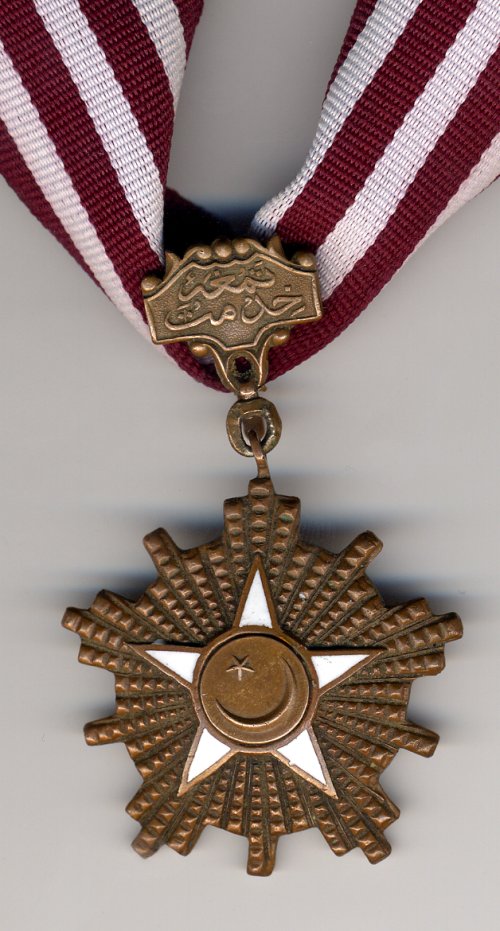
 0
0 -
The second variety is a 41-mm silver faceted star with a five pointed star in the centre. The points of the star are enameled white with a star and crescent in the centre, also on a white background. It is suspended from a crimson ribbon with two white stripes by a tablet reading (in Urdu) "Tamgha-i-Khidmat".
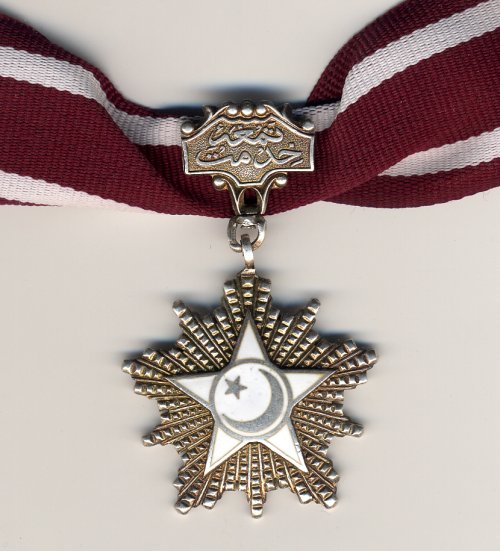
 0
0 -
2nd class (T.K.II) - A junior class to the T.K.I. Not to be awarded to those who already held the O.B.I. 2nd class. The decoration carried with it a monthly stipend of Rs. 25.
Roughly, this is the equivalent to the pre-1947 OBI 2nd class.
The first variety is a 47-mm silver faceted star with a five pointed star in the centre. The points of the star are enameled white with an unenameled star and crescent in the centre. It is suspended from a crimson ribbon with two white stripes by a tablet reading (in Urdu) "Tamgha-i-Khidmat".

 0
0 -
The second variety is a 41-mm silver-gilt faceted star with a five pointed star in the centre. The points of the star are enameled white with a star and crescent in the centre, also on a white background. It is suspended from a crimson ribbon with a single white stripe by a tablet reading (in Urdu) "Tamgha-i-Khidmat".
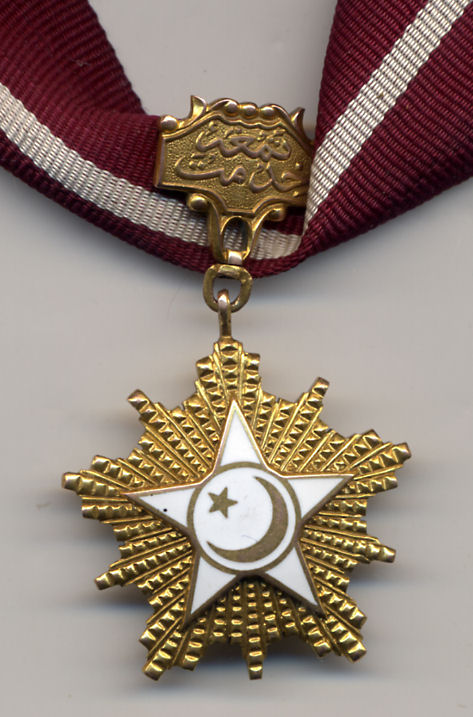
 0
0 -
1st class (T.K.I) - Awarded only to those who held the T.K.II or O.B.I. 2nd class. The award carried a monthly stipend of Rs. 40. On retirement, the awardee was to be granted the rank of Honorary Captain (if a Risaldar-Major or Subadar-Major) or Honorary Lieutenant (if a Risaldar, Subadar, or Jemadar).
Roughly, this is the equivalent to the pre-1947 OBI 1st class.
The first variety is a 47-mm silver-gilt faceted star with a five pointed star in the centre. The points of the star are enameled white with an unenameled star and crescent in the centre. It is suspended from a crimson ribbon with a single white stripe by a tablet reading (in Urdu) "Tamgha-i-Khidmat".


 0
0 -
Tamgha-i-Khidmat (Military) / Medal of Service (Military)
Awarded for long and meritorious service of a distinguished nature. Recipients of the award are entitled to use postnominal abbreviations as detailed below.
In many ways, this serves as a military class paralleling the Nishan-i-Khidmat; it is important to distinguish between this award and the Tamgah-i-Khidmat that is the fourth class of the Nishan-i-Khidmat. This decoration also represented somewhat of an overlap with the older, pre-1947, Order of British India and no soldier could be awarded the Tamgha-i-Khidmat who held the O.B.I. 1st class.
These awards are widely and easily available in Pakistan and are often added to "augment" invented groups. Be aware and be cautious.
Established: No.F.40(3)/Pres./57 of 16 March 1957, by the President of Pakistan. At some point in time -- unknown at present -- the badge was redesigned.
Obverse: A ten-pointed faceted star (metals and design vary by variety and by class, see below) with a superimposed five-pointed white-enameled star with a star and crescent in the center. Suspended as a neck badge from a suspender with the name of the decoration ?Tamgha-i-Khidmat?.
Reverse: A circle; the medal is sometimes named here, though not always "officially"
Ribbon: Basically crimson and white, but it differs by class; see detailed comments below.
0 -
Good Morning Ed!!!
I would appreciate it if you would move it so they can be merged.
 Doc
DocYour wish is my command, Doc. Done already, you'll note.
 0
0 -
Not lovely, but informational (with some nasty scans, sorry). The clasps, as shown above, 1-5.
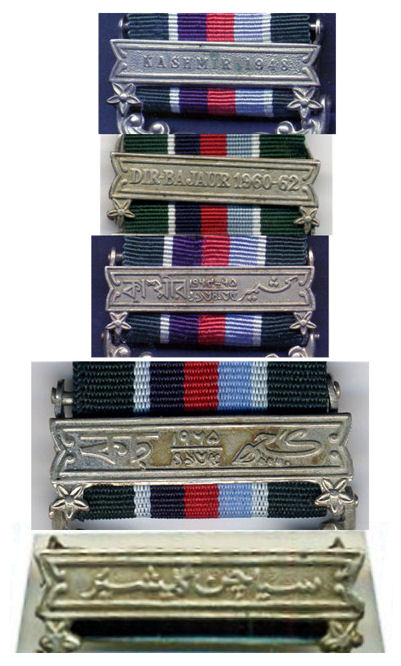

 0
0 -
The Pakistani continuation of the general service medal tradition came in 1957 (after attaining status as a republic) when the Tamgha-i-Diffa (Medal of Service) was established by notification No.F.40(3)/Pres./57 of 16 March 1957, by the President of Pakistan. As with India, there had been pre-republic discussion of the medal, and a draft warrant and design - with the cipher of Queen Elizabeth II! - had been drawn up but was never instituted.
Obverse: A 36-mm circular copper-nickel medal. Star and crescent in the center, surrounded by a wreath. Above, the inscription in Urdu ?Khidmat-i-Pakistan? or ?The Service of Pakistan.? Suspended from an ornate straight-bar swiveling suspender and a clasp with the campaign relevant to the award; bars both in English and bilingual bars in Urdu/Bengali have been seen. The medal is rarely seen named. The medal has also been seen and reported in gilt, but this seems to be a totally unofficial modification. The ribbon is 33 mm, green, with central stripes of dark blue, red, light blue, edged with thinner white stripes. Green 7 mm, white 2 mm, dark blue 5 mm, red 5 mm, light blue 5 mm, white 2 mm, green 7 mm.
Reverse: Plain, open circle in the center.
Clasps:
1- Kashmir-1948 ? monolingual in English ? For the October 1947-1 January 1949 first Indo-Pakistani war over Kashmir.
2- Dir-Bajaur 1960-62 - monolingual in English ? For the suppression of "tribal" rebellions in the North-West Frontier Province
3- Kashmir 1964-65 - bilingual in Urdu and Bengali - For border clashes in Kashmir preliminary to the 1965 Indo-Pakistani War.
4- Kutch 1965 ? bilingual in Urdu and Bengali ? For border clashes in the Rann of Kutch preliminary to the 1965 Indo-Pakistani War.
5- Siachen Glacier in Urdu - For the ongoing Indo-Pakistani "confrontation" on the Siachen Glacier.
None of these are officially named, though a very few have unofficial naming.
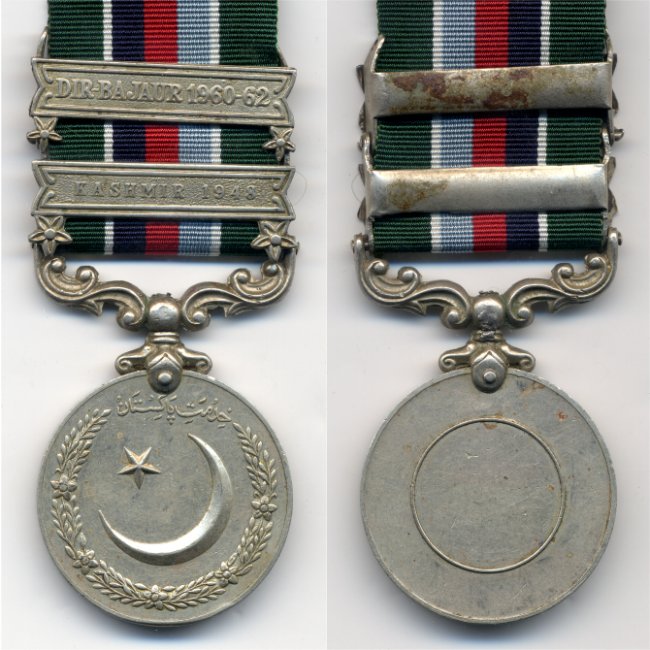
 0
0 -
While I don't have the God Powers to merge these, I can move it there, where someone more important than I can do the needful.
0 -
And his awards:
Polar Star, #270, 6 July 1946
Medal of Combat, #4144, 23 September 1948
Medal of Combat, #3159, 20 August 1951
Polar Star, #5556, 17 September 1953
Red Banner of Combat Valor, #603, 27 November 1958
probably 40th Anniversary MPR, #04758, 10 July 1961 (???)
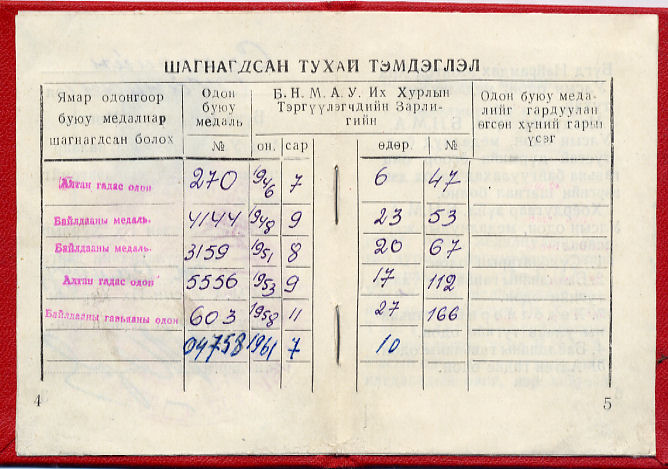
 0
0 -
Closeup of the recipient.
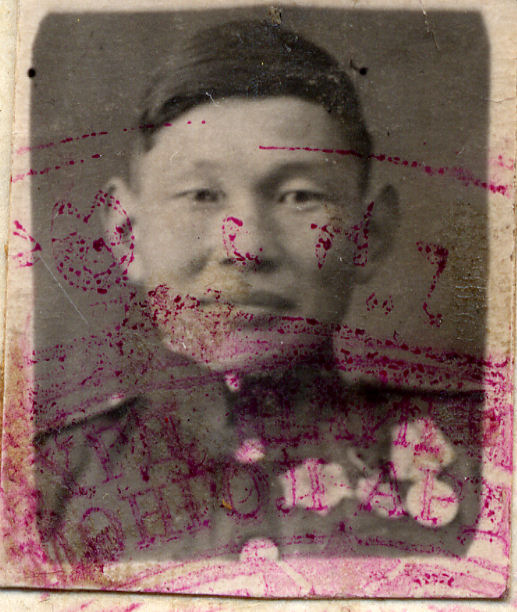
 0
0 -
Next page spread.
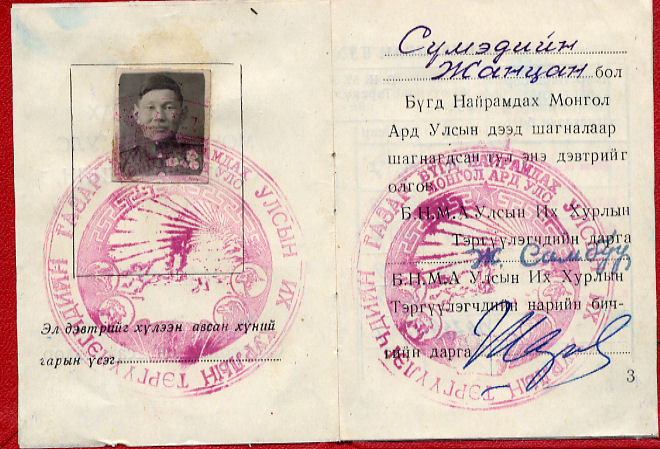
 0
0 -
First page.

 0
0 -
One more. The cover.
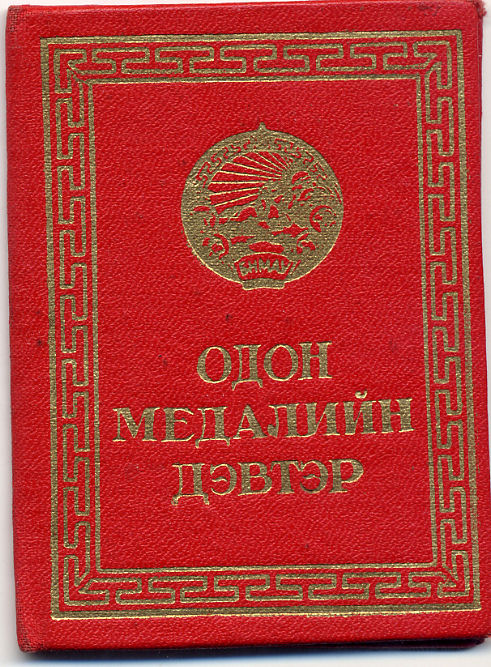
 0
0 -
Is it just me, or do they have a very "British" look to uniforms and accouterments?
This is true for both Pakistan and India (even for Bangladesh). Old traditions die hard. Guess that's why they're called "traditions"?
In recent years, as India has gotten closer to the US, there has been some contagion spreading from that side. A proliferation of meaningless little badges, using collar-badge stars for general-grade officers, etc. Sad.
0 -
Egypt ribbon bar #2:
1- Sinai Liberation Medal, Medal of Training
2- Medal of Training , Medal for Long Service and Good Example, October 6 Memorial Medal
3- Silver Anniversary of the Air Force Medal, Army Day Commemorative Medal, Twentieth Anniversary of the Revolution Medal, Golden Anniversary of the Air Force Medal

 1
1 -
And a couple of Egyptian ribbon bars.
#1:
1- Liberation Order, Military Order of Merit/Union Order, End of Occupation Decoration
2- Miltary Independence Medal, Victory Medal, Sinai Liberation Medal
3- Military Medal of Courage, Medal of Military Duty, Medal of Training, Medal of Distinguished Service
4- Medal of Long Service and Good Example, War Wounded (?), October 6th, Army Day Medal
5- 10th Anniversary of Revolution, 20th Anniversary of Revolution, ????. Kuwait Liberation Medal

 1
1 -
And the interior, dated 29 October 1965.
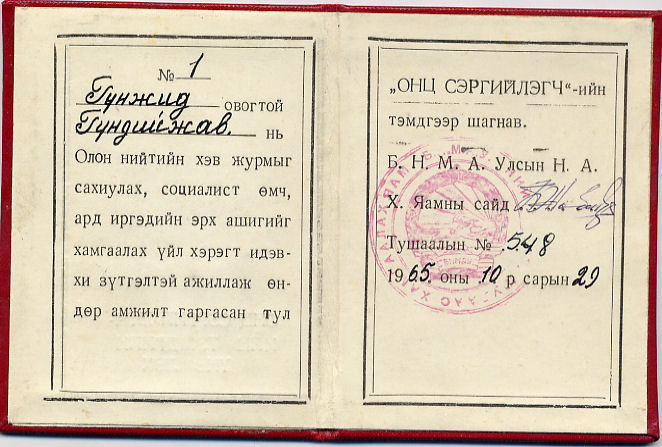
 0
0 -
And the document for the earlier version of The Best Policeman badge, F03. Exterior.
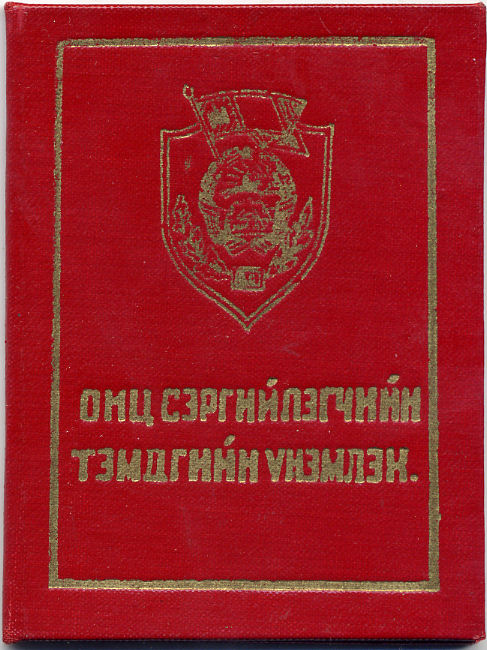
 0
0 -
Back
Just, for the record, I have a similar doument to the one Bob showed, dating 16 December 1982. No number. This gives us (sort of) a date range for this style of award book.
No reason to scan it, though?
0 -
Interior. Dated 9 July 1881.
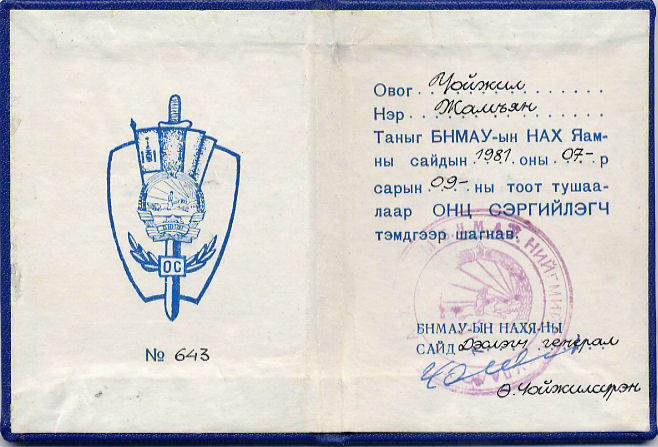
 0
0 -
Document for The Best Policeman, F04. Exterior.

 0
0 -
And the interior spread. Undated.
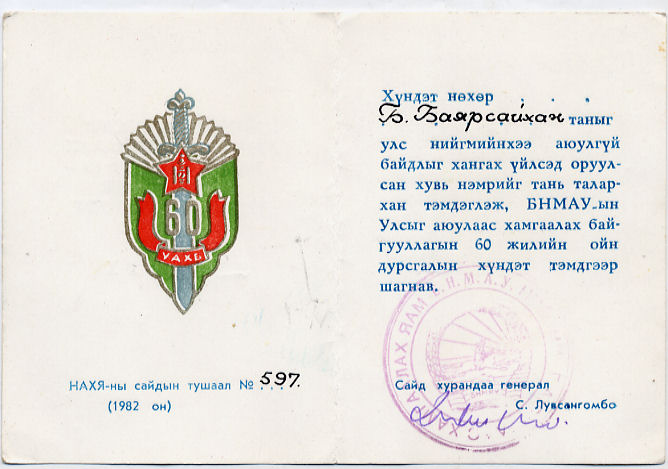
 0
0




PAKISTAN -- Tamgha-i-Khidmat
in South Asia
Posted
The second variety is a 41-mm bronze faceted star with a five pointed star in the centre. The points of the star are enameled white with a star and crescent in the centre, also on a white background. It is suspended from a crimson ribbon with three white stripes by a tablet reading (in Urdu) "Tamgha-i-Khidmat".